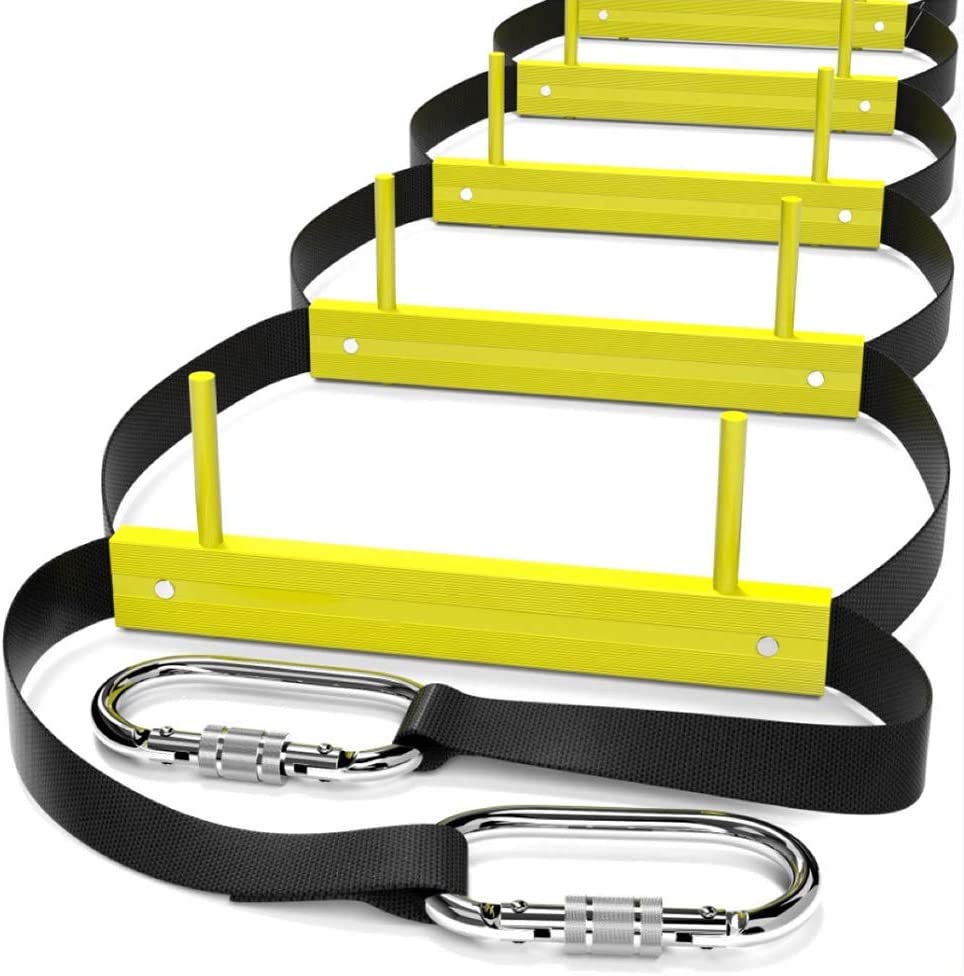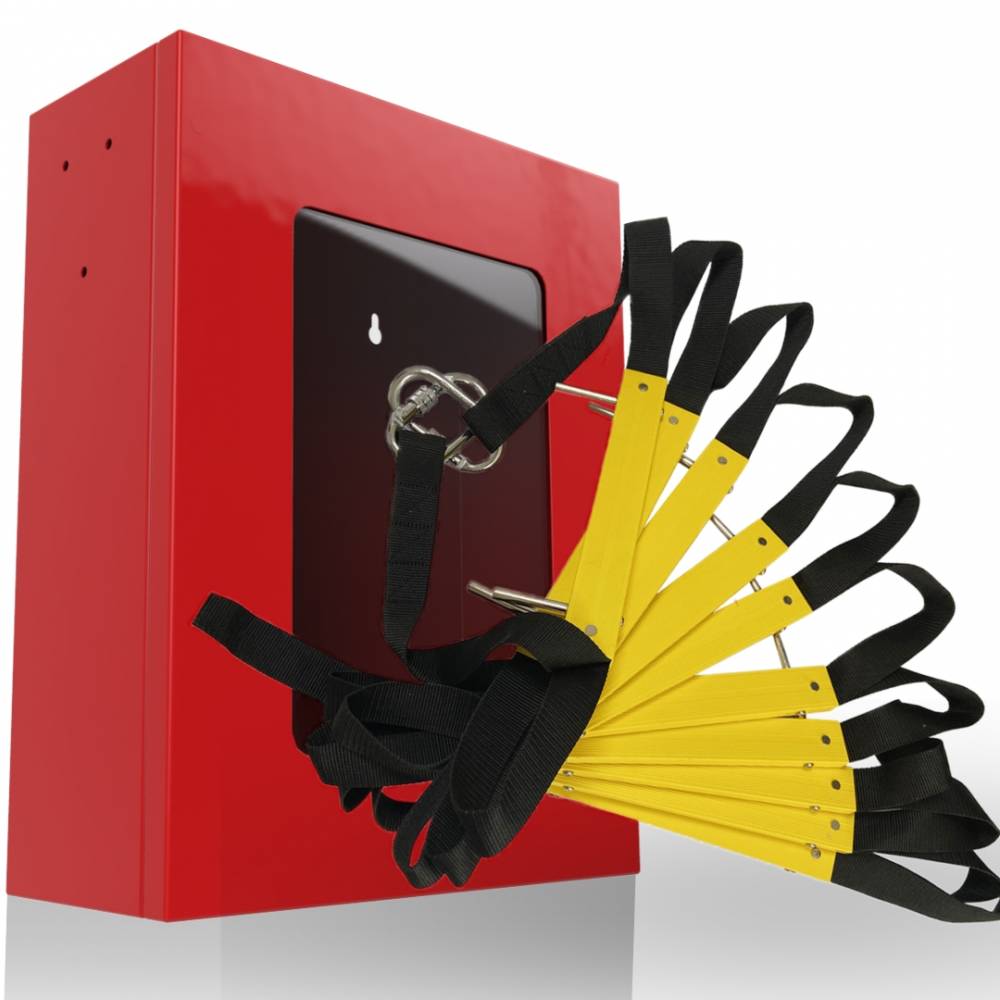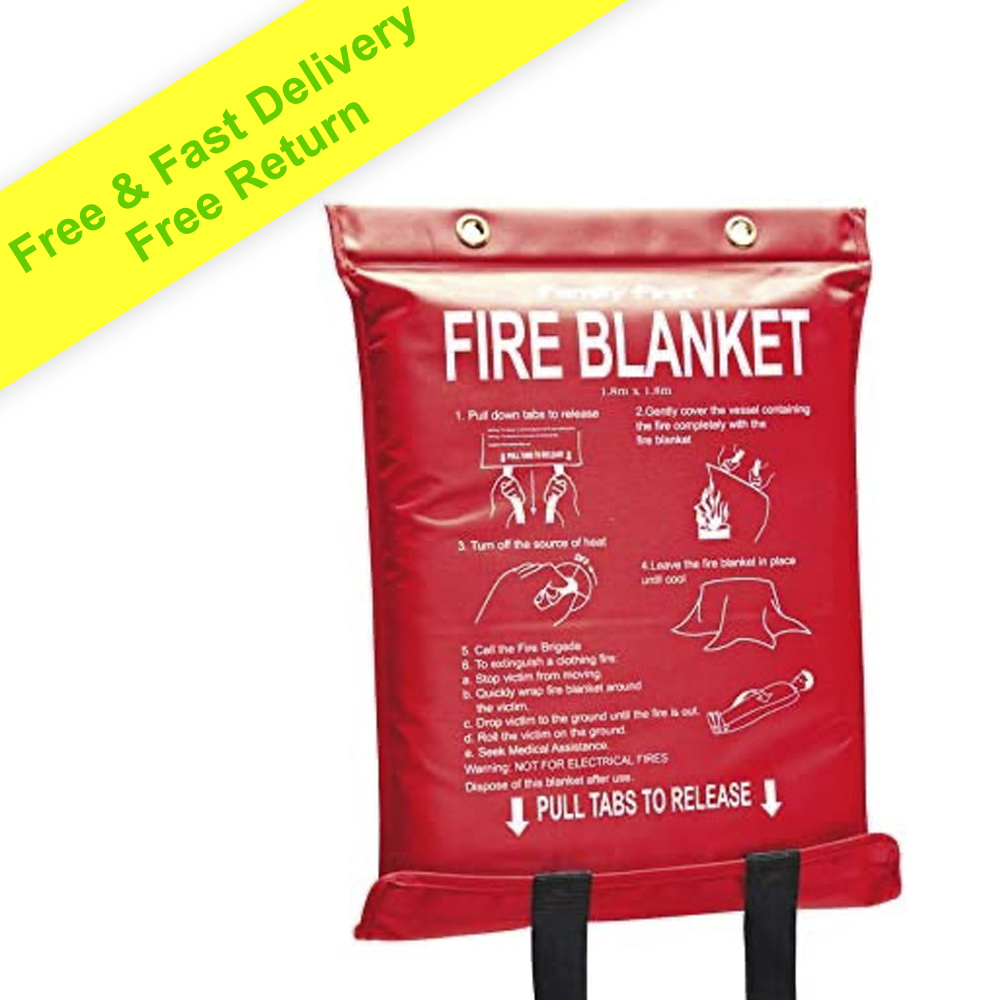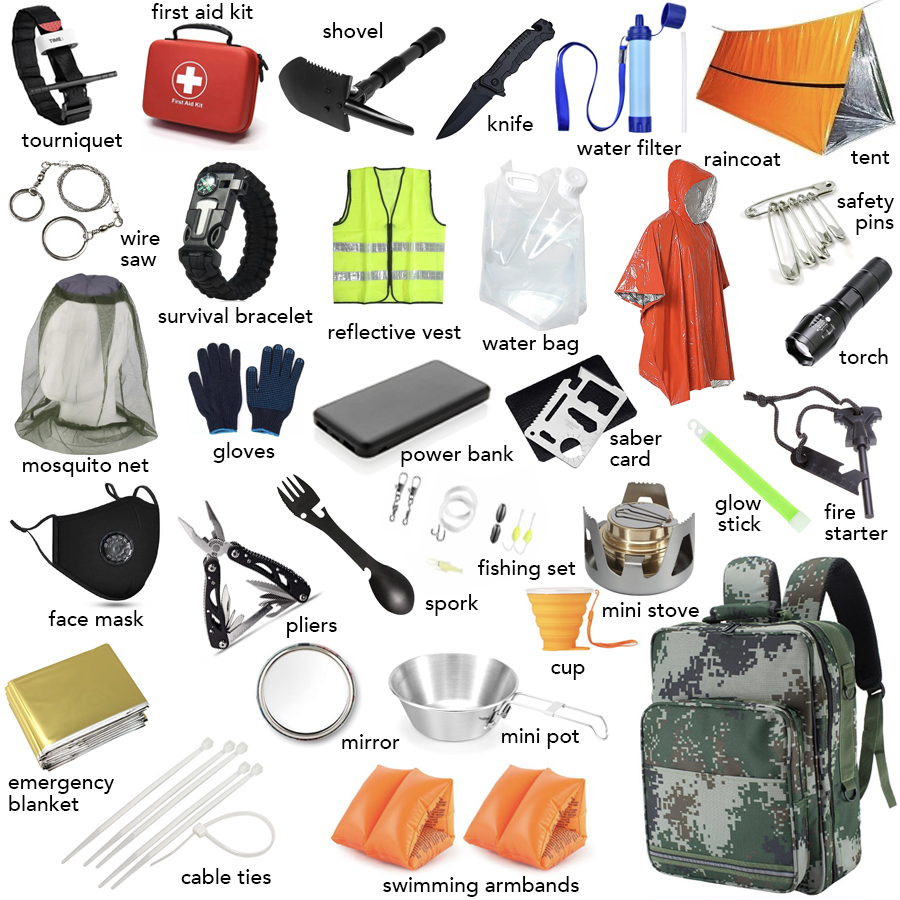FIRE PREPAREDNESS AND FIRE ESCAPE
SURVIVAL GUIDE IN CASE OF ROBBERY
SURVIVAL GUIDE DURING A CRASH AT SEA
SURVIVAL GUIDE ON A DESERT ISLAND
SURVIVAL GUIDE IN EXTREME COLD
FIRE PREPAREDNESS AND FIRE ESCAPE
The control and use of fire was an epoch-making event in human history. Controlled use of fire has kept us warm during long winters, helped us cook food, and kept us safe from many a beast. However, the catch is, “controlled use”, failing which fire can wreak havoc, turning entire buildings, homes, and entire landscapes into nothing but ash.
Accidents do occur, short circuits, cooking equipment or accessories catching fire, or even children playing with fire, are all common causes of household fires. While it is true that “Prevention is better than cure”, no matter how hard you try, accidents can still happen. Hence, is it necessary to stay prepared and plan for a worst-case scenario. At ISOP we are dedicated to keeping you and your loved ones safe with quality tools.
What forms the basics of fire preparedness are:
- Warning systems and fire safety equipment
- Fire escape plans
- Familiarize the escape plan
Warning Systems and Fire Safety Equipment
Here are a few Fire Warning and safety equipment that you can install easily at your home or office.
- Smoke Alarms
Well, you know how they say “There’s no smoke without fire”, in most cases of household fires, there cannot be a fire without smoke. Hence, smoke alarms can act as the first line of defense against fire, alerting you even before you face any danger immediately.
- Automatic Fire Sprinkler
While smoke alarms alert you in case of a fire, Automatic Fire Sprinklers start extinguishing fires as soon as they start, and also trigger other sprinklers in their vicinity to prevent the fire from spreading.
- Fire Extinguishers
How do you like having a firefighter on standby 24/7 at your home, ready to jump in and save the day when a fire starts to wreak havoc? Well, that is exactly what a fire extinguisher is, a mini firefighter in a can.
Experts recommend installing at least a 2 kg fire extinguisher on each level of your household. Remember that fire extinguishers are only one part of fire survival. Only use them to extinguish small self-contained fires or to clear a path for you to escape to safety.
- Fire Ladders
Fire ladders provide an easy and safe way for you to exit your household in case of a fire. Without a doubt, fire ladders are essential but are however more often than not they are neglected. Studies show that only 6% of households in the US have fire ladders.
Getting a safe and reliable ladder can often save you and your loved ones from serious injuries or even death. This is why we, at ISOP, have crafted the best Fire Escape Ladders for multistory houses, useful for both kids and adults. To know more about our fire ladders, click here.
- Fire Blankets
A fire blanket is the superhero cape equivalent for flames, swooping into house fires, and or shielding your loved ones from all the heat. They are made from fire-resistant materials like Fiberglass and can be your best ally in an emergency scenario. Get your superhero capes right away from our online store.
- Fire Evacuation Device for Pets
If you are like most of us, pets are family. While not all of us are John Wicks, we’d still go to great lengths to keep our pets safe. It is with this in mind, that we have designed the fire evacuation device for pets, to ferry your furry friends to safety during emergencies. Wondering where you can get these? Here, quickly hop on to our online store.
Fire Escape Plans
Now that we have installed the necessary tools to keep us safe in case of a fire. Let us look into how you can make a solid fire escape plan.
- Map out all possible exits
Identify all possible escape routes for each room and ensure that each member is familiar with at least two escape routes. Keep the routes clear of any obstructions, and maybe mark out the paths with glow-in-the-dark tapes.
- Basic fire safety
Teach your loved ones how to proceed in case of a fire. Heads low, covering mouths and noses, and shielding themselves with a fire blanket.
- Designated meeting point
Establish a meeting point, like a neighbor’s porch or the mailbox. The location should be ideally far from the house so that it is safe, but close enough so that everyone can reach there quickly and without any confusion.
- Check the safety equipment
Ensure that the smoke alarms and other fire safety equipment are working once a month. Also, have your household familiarize themselves with the smoke alarm sounds.
- Memorize the emergency phone number of the Fire Department
All household members should memorize the emergency phone number of the local Fire Department or emergency services.
- Once you’re out, stay out
If you managed to get out of your house in an emergency, but realize that someone is missing, inform the emergency respondents. DO NOT GO BACK INTO A BURNING BUILDING.
- Familiarize The Escape Plan
As the adage goes, “Practice makes perfect”, try to have mock drills with your family. Keep them as realistic as possible.
If you have children, tell them beforehand that there will be a drill, as the goal is not to frighten them but to practice. See if your children wake up to the sound of the smoke alarms, if not, designate someone to wake them up. If there’s a member with a disability, make the necessary arrangements.
How to survive in a fire?
But what if you find yourself in a burning building? What should you do to survive and get to safety?
- What to do if you’re trapped?
If you find yourself trapped in a room in a burning building, do not open any door without feeling it first. Check if the door is too hot with the back of your hand to not burn your palm. If that door is compromised, try to find another exit. If everything fails, seal the space around the door and vents with any available materials, preferably wet clothes or fire retardants, to prevent the entry of smoke and fire.
Even if the door doesn’t feel too hot, open slowly with caution, standing low to one side of the door as fumes and smoke may still enter.
Try to find a phone and contact the emergency services immediately and give them your exact location. If you can’t find a phone, shout as loud as you can. Flash a torch out of the window or signal using bright-colored clothes to give your location.
Try to ventilate your room, by opening windows. If you can’t open them, do not try to break the windows (unless necessary), especially on the higher floors, as this might cause a rain of broken glass on emergency respondents and others evacuating.
- How to evacuate
If you are the last one to evacuate, do not lock the doors behind you, rather just close them, as locking would impede the emergency respondents’ search and rescue. If your house or building has a designated emergency exit, proceed towards it, if not find the exit as given in the building’s emergency plan.
Most multistory buildings have an emergency stairwell that provides you with a safe exit from the building. Try not to panic and only descend towards your designated emergency rendezvous.
The elevator is a no-go. Stay low and crawl if necessary to avoid smoke and toxic fumes. If available, use a mask or damp cloth to cover your mouth and nose, and breathe shallowly through it. Hold your breath as much as possible and move swiftly.
What if someone catches fire
If you find yourself on fire, following these 3 steps can help save your life and reduce injuries.
STOP – moving
DROP – down to the floor
ROLL – around the floor
If you can access a fire blanket or a rug, cover yourself or the person on fire to smother the flames. Do not fan the flames as this will only make things worse. If a fire extinguisher is available, use it.
- When not to fight a fire
Leave the fire fighting to the professionals and try to evacuate the building immediately without panicking. But in case you have no choice but to firefight, then do it with caution. Make sure that your back is facing a safe exit route.
- Using extinguishers
While clearing your path out of the building or helping someone on fire, a fire extinguisher can come in handy. Remember to PASS.
P – Pull the pin
A – Aim at the base of the fire
S – Squeeze the handle
S – Sweep from side to side til you extinguish the fire
Final Thoughts
While it is great to be prepared for an emergency scenario, it is more desirable to prevent it from happening in the first place. According to the National Fire Protection Association, there are on average about 358,000 household fires, responsible for nearly 7 deaths a day. Minimizing the risk of fires while equipping yourself with the best safety tools and emergency equipment is the way to go.
LANDSLIDE SURVIVAL GUIDE
Landslides are common all over the world and can wreak havoc on life, property, infrastructure, and the environment. They are primarily caused by gravity acting on a steep slope, exacerbated by soil erosion, heavy rains, earthquakes, or volcanic eruptions.
LANDSLIDE: DO’S AND DONT’S
DO’s
- Stay Informed with the latest weather updates and follow instructions given by your local authorities.
- Evacuate Immediately If Warned of an incoming landslide in your area.
- Seek Shelter indoors if you can’t evacuate. Get to the highest floor of a sturdy building and avoid the windows/doors facing the landslide.
- Stay Alert for any signs of an incoming landslide, like cracking ground, or tilting trees.
- Have A Disaster Kit that consists of essential items like water, non-perishable food, and first aid supplies.
DON’Ts:
- Do Not Ignore Warnings issued by your local authorities or delay evacuation.
- Do Not Drive Through Landslide-Prone Areas, especially during severe weather conditions, and if you have to, stay alert and avoid parking on slopes.
- Do Not Stay In Your Vehicle if you are caught in a landslide, get out and move to higher ground or seek shelter.
- Do Not Build Near Landslide-Prone Areas, the construction activity can further add to the risk of a landslide.
- Do Not Attempt To Outrun A Landslide, long story short you can’t.
SURVIVAL TIPS
Here are some tips to survive if you find yourself caught in a landslide,
- Get Away from the landslide by moving perpendicularly to the landslide.
- Stay Away from the edges of the landslide, as this area is most unstable.
- Protect your head by covering it with headgear, cloth, or your arms.
- Stay Calm, as panicking can lead to poor decision-making and reduce your chances of survival.
- Have A Survival Plan for your plan. Ensure that they know how, where, and when to proceed in the event of a landslide.
- Avoid Debris Flow. If caught in one, grab onto a sturdy object such as a rock or a tree until the flow subsides.
- Be prepared for the aftermath: Other hazards such as gas leaks, flooding, or downed power lines can occur in the aftermath of a landslide, stay alert and be ready to evacuate again if necessary.
- Use a whistle to signal for help.
LANDSLIDE EMERGENCY KIT
Here’s all you’ll need for your landslide survival kit,
- Water carry at least a gallon of water per person
- Non-perishable food items like energy bars, and canned and dry food.
- First Aid Supplies like cotton balls, bandages, gauze, antiseptic and disinfectant liquids.
- Flashlight and extra batteries
- Emergency Whistle to signal to the search and rescue team members.
- Safety blankets can keep you warm at night.
- Masks to protect your lungs from debris and dust.
- Multipurpose tool for cutting or opening cans.
Do period checks of your kit and ensure that they are in good condition and have not passed their expiry dates, in the case of medical supplies and food items.
Earthquake Survival Guide
Being prepared for an earthquake is important, as it can help you and your family stay safe and minimize the damage caused by the earthquake. Here are some steps you can take to prepare for an earthquake and what to do when one is happening:
Before an Earthquake:
1. Prepare an emergency kit: This should include a first aid kit, non-perishable food, water, flashlights, and a portable radio.
2. Secure heavy items: Secure items such as bookcases, cabinets, and water heaters to walls or floors to prevent them from falling over.
3. Know your evacuation plan: Plan a safe route to evacuate your home or workplace if necessary.
4. Educate yourself: Learn about the earthquake risks in your area, how to turn off gas and electricity, and what to do if you are indoors, outdoors, or in a vehicle during an earthquake.
During an Earthquake:
1. Stay calm: Try to remain calm and stay in a safe location.
2. Take cover: Drop to the ground and take cover under a desk or table, or cover your head and neck with your arms if you can’t find shelter.
3. Stay away from windows: Stay away from windows and glass doors to avoid being injured by shattered glass.
4. Hold on: Hold on to your shelter or any sturdy furniture until the shaking stops.
5. Evacuate if necessary: If you are near the coast or in a high-rise building, you may need to evacuate quickly.
After an Earthquake:
1. Check for injuries: Check yourself and others for injuries and administer first aid if necessary.
2. Check for damage: Check your home for damage and turn off gas and electricity if necessary.
3. Evacuate if necessary: If you smell gas or see damage to your home, evacuate and seek assistance.
4. Stay informed: Listen to emergency broadcasts for updates and information on what to do next.
Remember, earthquake preparation is key to staying safe during an earthquake. Take the time to educate yourself and your family, and make sure you have an emergency plan in place.
Survival guide in case of robbery
If you find yourself in a situation where a robbery is taking place, it’s important to prioritize your safety and the safety of others. Here are some general guidelines to follow:
Stay calm: It’s natural to feel scared or panicked but try your best to remain calm. Keeping a clear mind will help you make rational decisions.
Cooperate: Compliance is crucial in a robbery situation. Listen carefully to the robber’s demands and follow their instructions. Avoid making sudden movements or attempting to be a hero, as it can escalate the situation and put you and others at risk.
Do not resist: Resisting a robber can increase the chances of violence. Your personal belongings can be replaced, but your life and well-being are irreplaceable. Avoid doing anything that might provoke the robber.
Maintain distance: If possible, try to maintain a safe distance from the robber. Keep your hands visible to show that you are not a threat, and avoid making sudden movements.
Be observant: Take mental notes of the robber’s physical appearance, any distinguishing features, and details about the situation. This information can be valuable to law enforcement later on.
Avoid eye contact: While it’s important to be observant, avoid direct eye contact with the robber. Eye contact can be seen as a challenge or a threat, and it’s best to avoid any actions that might escalate the situation.
Be patient: Robberies are usually brief. It’s important to remain patient and wait for the situation to de-escalate. Your safety is the top priority.
Alert authorities: Once the robber has left the scene, contact the police immediately. Provide them with a detailed description of the incident and any information you have about the robber.
Remember, these are general guidelines, and every situation is different. It’s important to assess the specific circumstances and prioritize your safety above all else.
How to prevent robbery
While it’s impossible to guarantee complete prevention of robbery, there are steps you can take to reduce the likelihood of becoming a target. Here are some tips for preventing robbery:
Stay aware of your surroundings: Be mindful of your environment and pay attention to people and activities around you. Avoid distractions such as excessive cellphone use, which can make you an easier target.
Walk confidently: Projecting confidence can make you less likely to be targeted. Walk with purpose, maintain good posture, and make eye contact with people around you.
Use well-lit and populated areas: Stick to well-lit streets and areas with plenty of people, especially during nighttime. Avoid isolated or dimly lit places where potential robbers can take advantage of the lack of visibility.
Trust your instincts: If something feels off or makes you uncomfortable, trust your intuition. If you sense danger, try to remove yourself from the situation as quickly and safely as possible.
Avoid displaying valuable items: Keep valuable possessions such as smartphones, jewelry, or cash concealed as much as possible. Displaying expensive items can attract unwanted attention and increase your risk of being targeted.
Be cautious with personal information: Avoid sharing sensitive personal information, such as your address or financial details, with strangers or on social media. Protecting your personal information reduces the chances of becoming a victim of identity theft or targeted robbery.
Secure your home: Use sturdy locks on doors and windows, install a security system if possible, and make sure to lock all entrances when leaving your home. Adequate lighting around your property can also deter potential burglars.
Vary your routines: Predictable routines can make you more vulnerable to robbery. Try to change up your routes and schedules whenever possible to make it harder for potential robbers to target you.
Travel in groups: When possible, travel with others, especially during nighttime or in unfamiliar areas. There is safety in numbers, and criminals are less likely to target a group of people.
Trust law enforcement: Report any suspicious activities or individuals to the police. They are there to help maintain community safety, and reporting potential threats can prevent robberies and assist in catching criminals.
Remember, these tips can help reduce the risk of robbery, but it’s important to prioritize your safety. If you ever find yourself in a dangerous situation, it’s best to comply with the robber’s demands rather than risk harm to yourself or others.
Dealing with a Flood
Floods can be devastating natural disasters, causing widespread damage and posing significant risks to personal safety. It’s crucial to be prepared and know how to protect yourself and your loved ones during a flood. Here is a comprehensive survival guide to help you navigate through this challenging situation:
Before the Flood:
1. Stay informed: Keep track of weather updates and flood warnings issued by local authorities through radio, TV, or mobile apps. Stay tuned to emergency alerts and evacuation orders.
2. Create an emergency kit: Prepare a disaster supply kit that includes essential items such as non-perishable food, water, medications, flashlights, batteries, first aid supplies, important documents, cash, and a battery-powered radio.
3. Secure your property: If time permits, secure your home by moving valuables to higher ground and placing sandbags around doors and windows to minimize water entry.
4. Develop an evacuation plan: Identify the safest evacuation routes and establish a meeting point for your family members. Practice the plan regularly to ensure everyone knows what to do in an emergency.
During the Flood:
1. Evacuate if instructed: If authorities issue an evacuation order, leave immediately. Follow designated evacuation routes and avoid driving or walking through flooded areas.
2. Move to higher ground: If evacuation is not necessary, move to the highest level of your home. Avoid basements and ground floors. Take your emergency kit with you.
3. Avoid contact with floodwater: Keep away from floodwater as it may be contaminated and contain hazards. Do not attempt to swim or walk through it, as even shallow water can be powerful and dangerous.
4. Stay connected: Keep your mobile phone charged and have a portable battery pack on hand. Contact emergency services if you require assistance or are in a life-threatening situation.
After the Flood:
1. Wait for the all-clear: Do not return home until authorities declare it safe to do so. Be cautious of structural damage and hazards like gas leaks or electrical issues.
2. Protect yourself: Wear protective clothing, such as gloves and boots, when cleaning up after a flood. Be cautious of sharp objects, debris, or contaminated materials.
3. Document the damage: Take photographs or videos of the damage to support insurance claims. Keep records of any expenses related to temporary accommodation or repairs.
4. Clean and disinfect: Thoroughly clean and disinfect your home, furniture, and personal belongings that may have come into contact with floodwater to prevent mold growth and minimize health risks.
5. Seek assistance: Contact your local disaster relief organizations or government agencies for assistance with recovery efforts, including temporary housing, financial aid, and counseling services.
Remember, personal safety is the top priority during a flood. Stay calm, follow the guidance of local authorities, and help one another. Being prepared and informed can significantly increase your chances of survival and recovery in the face of a flood.
Survival Guide During a Crash at Sea
1. Stay Calm: Remaining calm is essential during a crash at sea. Panic can cloud your judgment and hinder your ability to make rational decisions.
2. Put on a Life Jacket: Immediately put on a life jacket, ensuring it is securely fastened. A life jacket will help keep you afloat and increase your chances of survival in the water.
3. Assess the Situation: Quickly assess the severity of the crash and any immediate dangers, such as fire, flooding, or structural damage. Move away from any hazards and find a safe area.
4. Follow Crew Instructions: Listen carefully to the instructions provided by the crew or captain. They are trained to handle emergencies at sea and will guide you on the best course of action.
5. Locate a Lifeboat or Life Raft: Familiarize yourself with the location of lifeboats or life rafts on the vessel. Head to the nearest one and follow the crew’s instructions on how to board safely.
6. Stay Together: If possible, try to stay with your group or family members. This will ensure that everyone remains accounted for and can provide support to each other during the crisis.
7. Use Signaling Devices: If you are in a lifeboat or life raft, check for any signaling devices, such as flares, whistles, or distress signals. Use them to attract the attention of rescue teams.
8. Conserve Energy and Resources: If you are adrift at sea for an extended period, conserve your energy and resources. Avoid unnecessary movements and ration your food and water supplies.
9. Stay Hydrated: Drink small amounts of water regularly to stay hydrated. Avoid drinking seawater, as it will dehydrate you further.
10. Stay Warm and Protected: If you are in the water, try to stay as warm as possible. Huddle together with others to conserve body heat. If available, use any floating debris or life rafts to stay out of the water.
11. Look for Land or Other Vessels: Keep a lookout for land or other vessels that may assist. Scan the horizon regularly for any signs of help.
12. Stay Positive and Hopeful: Maintaining a positive mindset is crucial for survival. Support and encourage others around you, as it can boost morale and increase your chances of survival.
13. Stay Safe During Rescue: When rescue teams arrive, follow their instructions carefully. Board rescue vessels or aircraft safely and cooperate with the rescuers.
Remember, survival at sea can be challenging, and the circumstances may vary. Following these guidelines, staying calm, and using your best judgment will greatly increase your chances of surviving a crash at sea.
Survival Guide on a Desert Island
1. Assess Your Surroundings: Take a moment to assess your surroundings and gather information about the island. Look for sources of fresh water, food, and potential shelter locations.
2. Locate Fresh Water: Finding a source of fresh water is crucial for survival. Look for streams, rivers, or natural springs. If none are available, explore the island for rainwater catchment areas such as depressions or hollows in rocks.
3. Build Shelter: Create a shelter to protect yourself from the elements. Use available materials such as branches, leaves, or rocks to construct a sturdy shelter that provides shade and protection from wind and rain.
4. Find or Create Fire: Fire is essential for warmth, cooking, and signaling for rescue. If you have matches or a lighter, use them to start a fire. If not, try friction-based methods like rubbing sticks together or using a magnifying glass to catch sunlight. Collect dry leaves, twigs, and other flammable materials to help sustain the fire.
5. Search for Food: Explore the island for sources of food. Look for edible plants, fruits, nuts, and insects. Learn about the local flora and fauna to identify safe and edible options. Try fishing, crabbing, or setting traps to catch seafood.
6. Signal for Rescue: Increase your chances of being rescued by creating visible signals. Use mirrors, bright clothing, or reflective materials to attract attention from passing boats or aircraft. Also, create a large SOS sign on the beach using rocks or branches.
7. Prioritize Safety: Be cautious of potential hazards on the island, such as poisonous plants, dangerous animals, or rough terrain. Take precautions to avoid injury and illness. If injured, tend to wounds promptly to prevent infection.
8. Maintain Mental Well-being: Surviving on a desert island can be mentally challenging. Stay positive and focus on small accomplishments. Keep yourself occupied by building tools, making crafts, or finding ways to stay entertained.
9. Preserve Energy and Resources: Conserve your energy and ration your resources. Prioritize essentials like food, water, and shelter. Avoid unnecessary physical exertion and rest when needed.
10. Stay Hopeful and Patient: Survival on a desert island may take time. Stay hopeful and patient, knowing that rescue may come eventually. Maintain a positive mindset and believe in your ability to overcome challenges.
Remember, survival on a desert island requires resourcefulness, adaptability, and resilience. Each situation is unique, so use your judgment and adapt these guidelines to fit your specific circumstances.
Survival Guide in the Desert
1. Find Shelter: Seek shelter from the intense heat and sun. Look for natural shade, such as under a rock overhang or a large tree. If no natural shelter is available, create your own using a tarp or any available materials.
2. Conserve Water: Water is crucial for survival in the desert. Conserve your water supply by rationing it and avoiding activities that cause excessive sweating. Look for sources of water such as springs, cacti, or dry riverbeds. Collect dew or moisture using a cloth or plastic sheet.
3. Protect Yourself from the Sun: The desert sun can be extremely harsh. Protect yourself by wearing loose, lightweight, and light-colored clothing that covers your skin. Use a wide-brimmed hat, sunglasses, and sunscreen to shield yourself from the sun’s rays.
4. Find Food: While finding food in the desert can be challenging, there are some options. Look for edible plants, fruits, seeds, and insects. Be cautious and avoid eating anything you are not familiar with unless you are certain it is safe.
5. Signal for Help: Increase your chances of being rescued by creating visible signals. Use reflective materials, mirrors, or brightly colored objects to attract attention from passing aircraft or people. Create a large SOS sign on the ground using rocks, branches, or any available materials.
6. Stay Oriented: It is easy to get disoriented in the desert. Pay attention to landmarks, the position of the sun, and natural formations to help you navigate. If possible, have a compass or GPS device to assist you.
7. Protect Yourself from Desert Wildlife: Be aware of desert wildlife, such as snakes or scorpions. Avoid contact with them and be cautious when reaching into crevices or under rocks. Shake out your shoes and clothing before putting them on.
8. Stay Hydrated: Drink water regularly to stay hydrated. Even if you do not feel thirsty, continue to drink small sips of water throughout the day. Avoid alcohol and caffeine, as they can dehydrate you.
9. Stay Positive and Calm: Survival in the desert can be mentally and physically challenging. Stay positive and focused, as panic can lead to poor decision-making. Take deep breaths, practice mindfulness, and stay calm.
10. Prepare for Cold Nights: Desert temperatures can drop significantly at night. Be prepared for the cold by having warm clothing, a sleeping bag, or a blanket to keep you comfortable and prevent hypothermia.
Remember, surviving in the desert requires careful planning, resourcefulness, and resilience. Use your judgment, adapt to the specific circumstances, and prioritize your safety and well-being.
Survival Guide in Extreme Cold
1. Find or Build Shelter: Seek or create shelter to protect yourself from the extreme cold. Look for natural shelters like caves or rock formations. If none are available, build a shelter using materials such as branches, snow, or any available resources. Insulate the shelter with additional layers like pine branches or blankets.
2. Layer Clothing: Dress in layers to trap warmth and regulate body temperature. Wear a moisture-wicking base layer, an insulating middle layer, and a waterproof outer layer. Add or remove layers as needed to avoid sweating or becoming too cold.
3. Keep Extremities Warm: Pay extra attention to keeping your hands, feet, and head warm. Wear insulated gloves, thick socks, and a hat or balaclava to prevent heat loss from these areas. Use hand and foot warmers if available.
4. Stay Dry: Moisture can accelerate heat loss in cold environments. Keep clothing and gear dry. If you sweat, remove damp layers and replace them with dry ones. Avoid unnecessary contact with snow or water.
5. Build a Fire: If possible, start a fire to provide warmth and a heat source for cooking. Gather dry firewood and use fire-starting materials like matches, lighters, or a fire starter kit. Ensure the fire is well-ventilated and safely contained.
6. Hydrate and Eat Adequately: Stay hydrated by drinking plenty of fluids, even if you don’t feel thirsty. Eat high-calorie and high-fat foods to provide your body with the energy it needs to stay warm. Pack energy bars, nuts, and other non-perishable foods in your survival kit.
7. Signal for Help: If you need rescue, use signaling devices such as a whistle, mirror, or flare to attract attention. Create a visible SOS sign in the snow or use brightly colored materials to increase your visibility to search parties or aircraft.
8. Prevent Frostbite and Hypothermia: Be vigilant about preventing frostbite and hypothermia. Keep an eye out for signs such as numbness, tingling, or discoloration of the skin. If symptoms occur, seek shelter, remove wet clothing, and warm affected areas with body heat or warm water (not hot).
9. Stay Active: Physical activity generates body heat, so try to stay active within your limits. Engage in light exercises or perform tasks that keep you moving, such as gathering firewood or building your shelter.
10. Stay Positive and Alert: Maintaining a positive mindset is crucial for survival in extreme cold. Stay focused, alert, and mentally strong. Avoid panic and make rational decisions based on the situation.
Remember, extreme cold conditions can be life-threatening, so it’s important to prioritize safety and take necessary precautions. Use your judgment, adapt to the specific circumstances, and seek professional help if available.













